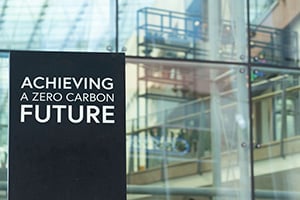By Anne Nichols
Sustainablility Analyst Intern, Sustainable Investment Group (SIG)
It’s Time for the Poster Child of Urban Sprawl to Grow Up!
 Atlanta has long been called the poster child of urban sprawl. It’s about time we grew up, not out. Baby boomers are retiring and Atlanta-headquartered companies like Coca Cola, Home Depot, and Delta are thriving. Young professionals are chomping at the bit and flocking to Atlanta to eat up the swelling job market. So what does this mean for the future expansion of Atlanta? Without change, the city might expand to the Alabama border, commutes could last an upwards of two hours, and smog warnings may raise to an unhealthy or even hazardous level.
Atlanta has long been called the poster child of urban sprawl. It’s about time we grew up, not out. Baby boomers are retiring and Atlanta-headquartered companies like Coca Cola, Home Depot, and Delta are thriving. Young professionals are chomping at the bit and flocking to Atlanta to eat up the swelling job market. So what does this mean for the future expansion of Atlanta? Without change, the city might expand to the Alabama border, commutes could last an upwards of two hours, and smog warnings may raise to an unhealthy or even hazardous level.
Fortunately, change is coming. Millennials are rejecting their parent’s dream of individually-packaged homes nestled in polished subdivisions. They are giving up manicured green lawns for restaurants, theaters, and grocery stores in their backyards. They are sacrificing the view of the stars at night for the skyline of buildings that twinkle brighter. They are surrendering their cars for bikes, walking shoes, and unlimited MARTA passes. The youth’s desire to be engulfed in the vibrant city life is what will save Atlanta from urban sprawl.
Howard Frumkin, the Dean for the School of Public Health at University of Washington, discusses the idea of “healthy habitats” for humans to thrive in his TED talk. One of his main arguments for healthy habitats is doing away with urban sprawl as “it means a standard part of the human habitat becomes massive projects of road construction.” He also goes on to describe the problems with suburban neighborhoods as designed with high density residential areas and low mixed-uses such as retail or community services, thus requiring a car ride simply to buy a gallon of milk or visit a park.
These residentially focused neighborhoods and the mass influx and exodus of cars into the city every day present economic, health, and environmental complications for both individuals and the local government.
Economically, everyone should be able to live in a more walkable and diverse use area. The individual saves money on car repairs and rising gas prices. The government doesn’t have to spend funding on infrastructure extending out of the Perimeter, and can now concentrate their funds within the city. However, the entity perhaps profiting the most is the developer. Christopher Leinberger, an expert in Metropolitan land use strategy, notes in a report about Atlanta that the rent price per square foot for real estate located in walkable neighborhoods is 112% higher than their spread-out suburban counterparts.
A large amount of time, arguably one of our most precious currencies, is also lost to commutes. According to a study published in The Atlantic, the average American spends 38 hours a year stuck in traffic, while the average Atlantan spends 52 hours a year stuck in traffic. That means we’re spending over a work week’s worth of time getting to work!
The ability to walk to work is a luxury for many, but it shouldn’t have to be. Walking to work and to surrounding amenities can greatly boost one’s health. In a report published by the Ramblers and Macmillan Cancer Support, physical inactivity causes 6% of deaths worldwide. It can also reduce one’s lifespan by 3-5 years.
Being active and walking every day can help maintain a healthy weight, increase good cholesterol, reduce blood pressure, build healthy muscles and bones, and reduce the risk of falls. On top of walking, there is an added benefit for doing it in green spaces. A study from Essex University shows that walking in green spaces may result in reduced stress, improved mood, and longer attention spans.
Smog Season begins on April 1st in Atlanta as the higher temperatures add to poorer air quality. Georgia Commute Options offers cash incentives for commuters that choose alternative forms of commuting such as carpooling, vanpooling, taking the transit, teleworking, walking, or biking to work. Learn more, here. Two of SIG employees do alternative commuting—Alyson rides her bike and also takes MARTA and Kathy takes MARTA and then walks one mile to our building.
At Sustainable Investment Group (SIG) we offer engineering services, LEED consulting, and LEED exam preparation training, in an effort to help our clients and the communities we work in to achieve higher levels of sustainability.
© 2015 Sustainable Investment Group (SIG). All Rights Reserved.



